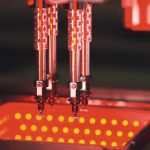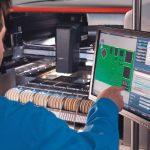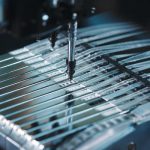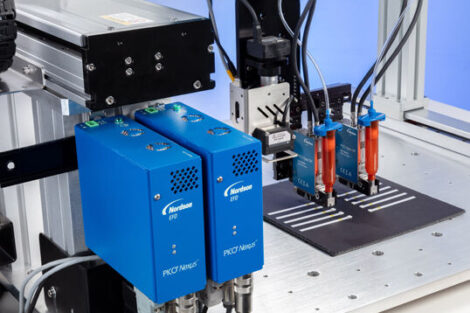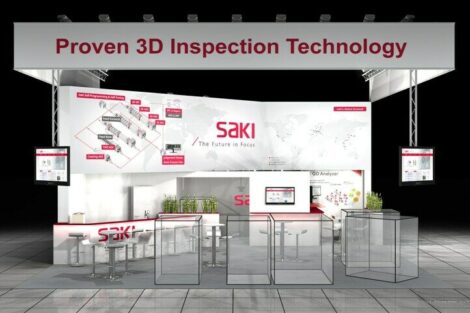While developing the Paraquda, the new SMD placement machine from Essemtec, the engineers have built in the best and most accurate components that today’s drive and measurement technology has to offer. The result is a machine that sets industry standards in speed, ease of use, reliability and application range.
Adrian Schaerli, Azular GmbH for Essemtec AG
The idea that a ball screw drive is better than a belt drive has been widely accepted for years, especially when it comes to SMD placement machines. Essemtec’s engineers thoroughly tested these two drive systems, among others, under intensive practical testing conditions before they began designing the new Paraquda SMD pick-and-place system. With the test results, the decision was easy: The main drive system of the machine would be designed using a belt drive in combination with a real-time control system. The pick-and-place head would be mounted on an H-portal, giving the machine excellent static and dynamic properties.
Essemtec also undertook intensive basic and operational research for the optimal design of the placement head and the vision system, especially for vision lighting. For this, deve- lopment, boundary conditions and state-of-the-art technologies were the customers’ only requirements. As a result, the Paraquda has become an advanced and modern placement system. The reasons for this include the technical implementation, the software and operation. Additionally, it has the broadest component spectrum and application range. The Paraquda is well prepared for both current and future electronics manufacturing.
It is clear that a belt drive on its own does not make a viable drive system for an SMD pick-and-place machine. It also requires a high-reso-lution measuring system and an extremely fast and reliable drive control system. However, a combination of the right components can form a drive system far superior to a ball screw.
Good old belt drive – re-implemented
The benefits include higher maximum speed, a longer life time, lower cost and easier maintenance of the belt drive. With this drive type, the assembly head of the Paraquda can be positioned much faster and the throughput is higher. The mass of the head assembly is relatively high, as well as the acceleration forces that occur. With such strains, a belt shows significantly less wear and, therefore, is more durable than a metal spindle. Also, a belt can be exchanged in the field more easily. Thanks to the field-proven belt drive system, Paraquda can mount faster, more reliably and at lower cost.
H-drive with real-time regulation system
A well-known disadvantage of the belt drive is the overshoot due to belt elongation. This can be reduced to an extent that it is meaningless even for the most precise applications. This is accomplished by appropriate dimensioning of the belt and the use of a real-time control system. Therefore, the Paraquda features a high-speed bus and regulation system that can calculate the current location values immediately and readjust the position without delay.
The placement head is mounted on an H-drive system. The X and Y axes are autonomous, which allows a dynamic travel path optimi-zation. The Y-Axis is driven with AC servo motors on both sides to ensure that mechanical transmission errors are completely avoided. For the exact positioning and parallelism, linear measurement systems are used that transmit the current position values without delay to the machine control system. The built-in linear scales have a resolution in the micrometer range, which allows Paraquda to place ultra-fine-pitch and 01005-components.
Each placement axes for fine pitch and chips
The four placement axes of the pick-and-place head are arranged in a square. This arrangement was chosen for two reasons. First, the Paraquda can always pick two components at the same time, regardless of whether the feeders are in front, rear, left or right. If the axes were arranged in a row, this would not be pos-sible. The other reason is the speed increase over the vision system: The 2-megapixel camera can take pictures of all four parts at once and the image processor (Cognex SMD-4) can ope-rate in parallel.
The vision system has a special lighting process that incorporates three independent lighting levels. This overcomes the drawback of most other image processing systems, as different components often require different lighting. Therefore, for four different components, four different pictures would be needed. The special illumination of the pick-and-place machine is optimized in such a way that different components are properly lit and only one picture taken.
Each of the four placement spindles is independent of the others. Each has its own vertical and rotational drive. The latter sits directly on the rotation axis and, therefore, is precise and play-free. This is why each axis can place the complete component spectrum from the smallest of chips to large QFPs and BGAs. The optimization software that optimizes the assembly sequence and minimizes the travel path always uses four equivalent resources. The assembly machine is redundant, flexible and much faster than other four-spindle assembly machines.
ePlace simplifies complexity
Paraquda is the first machine to use ePlace for operation and programming. The intuitive, graphical user interface provides a level of comfort previously unseen on a pick-and-place machine. It makes operation secure, offers tool-tips and context-sensitive help, completes entries automatically, searches intelligently, and sorts lists effectively. In short, ePlace always reacts in a way that the user expects it to and provides assistance when needed.
Above all, ePlace makes controlling a complex machine an easy task. Because not every ope-rator speaks English and staff with language skills is expensive, the software uses graphical representations to create clarity, and when text is unavoidable, the support of multiple languages is provided. Tutorials are integrated as well, allowing new staff to be trained quickly.
Working with ePlace on the Paraquda requires neither mouse nor keyboard – the software is directly controlled via a 19“ wide ergonomic touch screen. The screen can be adjusted vertically and angled into a position that is most convenient for the user. ePlace also supports users with unlimited zooming functionality and optimizes views for less scrolling and clicking.
Quality management prevents errors and costs
Setup and placement errors must be avoided because they can lead to extremely costly re-pairs or can turn a complete series into electronic waste. ePlace gives Paraquda a quality and job management system that controls the main source of error – the human.
The base is a job management with archiving system on which other functions are built, such as a job planning module, a setup optimization routine, a setup list generator, component sto-rage management and more. For feeder setup and retro-fitting, a bar code reader is used, which is the safest and fastest way to assign a component to a feeder. Setup errors are excluded and the stock of available components is updated automatically.
The only error sources left are mislabelling or mix-up from the vendor because most of the SMD components look very much the same. The Component Verification Unit (CVU) option provides protection against these errors. The CVU checks the electrical values of a component before mounting, for example, the resistance, the capacity or the polarity.
Places all parts and dispenses too
The Paraquda is four machines in one: a chip placer, a fine-pitch placer, a special component placer and a dispensing machine. In addition to the SMD mounting head, up to two dispensing valves can be integrated simultaneously. These can be used to dispense solder paste, adhesives, flux or other liquids. Dispensing of lines, curves or dots is possible. With this feature, a Paraquda can be a die bonder, an IGBT assembly machine or it can be used for hybrid technologies.
The placement head is equipped with four axes, each one of them with its own vertical and rotation drive system and each can be controlled individually. The range of components that can be placed with this head is extensive: It spans 01005 resistors up to 100 mm square components. The maximum component height is specified with 25 mm, the minimum pitch with 0.3 mm.
Reducing changeover cost
To work flexibly with an SMD pick-and-place system, three variables are required: A large feeder capacity, intelligent feeders that are automatically recognized and feeders that can be exchanged during production. Paraquda is a result of more than 18 years of Essemtec’s experience in the manufacture of highly flexible assembly systems.
Thanks to Swiss watch technology, Essemtec has always built the narrowest SMD feeders in the world. These principles have been implemented to the design of the Paraquda. They are the same feeders used on the FLX pick-and-place systems. A customer can switch with ease to the faster Paraquda, whose feeder capacity is also higher: 240 feeder slots are available on a standalone machine, 120 to 200 on an in-line model, depending on the PCB width.
The large feeder capacity handles fixed feeder sets that allow the production of several jobs without requiring feeder changeover. Additio-nally, it produces PCBs with very high complexity, whereas other machines require at least two or more passes.
As previously mentioned, Essemtec feeders are intelligent. They are recognized automatically by the Paraquda and they can be retrofitted while the machine is running. This shortens the changeover effort, reduces standing time between two jobs to almost nothing and increases the system’s utilization rate. The Paraquda can generate significant savings in setup costs, an important contribution to the reduction of manufacturing costs.
All from One Source – Worldwide
The Paraquda is available in two models, a stand-alone and an in-line system with SMEMA interface, which enables an easy connection to other in-line machines. Essemtec also provides a comprehensive range of machines required for functional SMT assembly from one source, such as printers, dispensers, soldering and curing ovens, handling modules, storage systems and software for production planning.
With the Paraquda, Essemtec introduces a new product destined to become a leading system in the pick-and-place market. The technologies developed for this machine such as the ePlace user interface, the high-speed vision system or the new damping materials are being used for the first time in pick-and-place machines and are setting new trends in the world of placement.
SMT/Hybrid/Packaging Booth 7-203
Zusammenfassung
Bei der Entwicklung des neuen SMD-Bestückungsautomaten haben die Ingenieure von Essemtec auf die moderste und präziseste Antriebs- und Regelungstechnik gesetzt, die zurzeit im Markt verfügbar ist. Dabei ist eine Maschine entstanden, die sowohl einen hohen Standard erfüllt als auch einfach zu bedienen und zuverlässig ist.
Dans le cadre du développement de nouveau machines de placement automatiques pour CMS, les ingénieurs d’Essemtec ont misé sur les techniques de régulation et d’entraînement les plus modernes et les plus précises de notre époque. Le résultat en est une machine qui atteint un niveau de qualité très élevé, simple d’utilisation et fiable.
Share:



